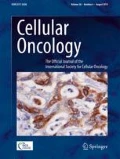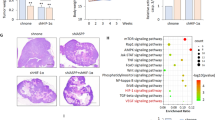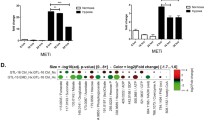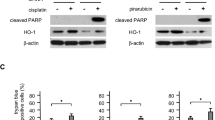Abstract
Background
Miconazole is an imidazole antifungal agent that has amply been used in the treatment of superficial mycosis. Preliminary data indicate that miconazole may also induce anticancer effects. As yet, however, little is known about the therapeutic efficacy of miconazole on cancer and the putative mechanism(s) involved. Here, we show that miconazole suppresses hypoxia inducible factor-1α (HIF-1α) protein translation in different cancer-derived cells.
Methods
The effect of miconazole on HIF-1α expression was examined by Western blotting and reverse transcriptase polymerase chain reaction assays in human U87MG and MCF-7 glioma and breast cancer-derived cell lines, respectively. The transcriptional activity of the HIF-1 complex was confirmed using a luciferase assay. To assess whether angiogenic factors are increased under hypoxic conditions in these cells, vascular endothelial growth factor (VEGF) levels were measured by ELISA. Metabolic labeling was performed to examine HIF-1α protein translation and global protein synthesis. The role of the mammalian target of rapamycin (mTOR) signaling pathway was examined to determine translation regulation of HIF-1α after miconazole treatment.
Results
Miconazole was found to suppress HIF-1α protein expression through post-transcriptional regulation in U87MG and MCF-7 cells. The suppressive effect of HIF-1α protein synthesis was found to be due to inhibition of mTOR. Miconazole significantly inhibited the transcriptional activity of the HIF-1 complex and the expression of its target VEGF. Moreover, miconazole was found to suppress global protein synthesis by inducing phosphorylation of the translation initiation factor 2α (eIF2α).
Conclusion
Our data indicate that miconazole plays a role in translational suppression of HIF-1α. We suggest that miconazole may represent a novel therapeutic option for the treatment of cancer.




Similar content being viewed by others
References
J.J. Lou, Y.L. Chua, E.H. Chew, J. Gao, M. Bushell, T. Hagen, Inhibition of hypoxia-inducible factor-1 alpha (HIF-1alpha) protein synthesis by DNA damage inducing agents. PLoS One 5, e10522 (2010)
A.J. Majmundar, W.J. Wong, M.C. Simon, Hypoxia-inducible factors and the response to hypoxic stress. Mol. Cell 40, 294–309 (2010)
G.L. Semenza, Targeting HIF-1 for cancer therapy. Nat. Rev. Cancer 3, 721–732 (2003)
W.G. Kaelin Jr., The von Hippel-Lindau tumour suppressor protein: O2sensing and cancer. Nat. Rev. Cancer 8, 865–873 (2008)
N. Masson, C. Willam, P.H. Maxwell, C.W. Pugh, P.J. Ratcliffe, Independent function of two destruction domains in hypoxia-inducible factor-alpha chains activated by prolyl hydroxylation. EMBO J. 20, 5197–5206 (2001)
D.J. Manalo, A. Rowan, T. Lavoie, L. Natarajan, B.D. Kelly, S.Q. Ye, J.G. Garcia, G.L. Semenza, Transcriptional regulation of vascular endothelial cell responses to hypoxia by HIF-1. Blood 105, 659–669 (2005)
C.D. Young, A.S. Lewis, M.C. Rudolph, M.D. Ruehle, M.R. Jackman, U.J. Yun, O. Ilkun, R. Pereira, E.D. Abel, S.M. Anderson, Modulation of glucose transporter 1 (GLUT1) expression levels alters mouse mammary tumor cell growth in vitro and in vivo. PLoS One 6, e23205 (2011)
N. Shaida, R. Launchbury, J.L. Boddy, C. Jones, L. Campo, H. Turley, S. Kanga, A.H. Banham, P.R. Malone, A.L. Harris, S.B. Fox, Expression of BNIP3 correlates with hypoxia-inducible factor (HIF)-1alpha, HIF-2alpha and the androgen receptor in prostate cancer and is regulated directly by hypoxia but not androgens in cell lines. Prostate 68, 336–343 (2008)
H. Bando, T. Atsumi, T. Nishio, H. Niwa, S. Mishima, C. Shimizu, N. Yoshioka, R. Bucala, T. Koike, Phosphorylation of the 6-phosphofructo-2-kinase/fructose 2,6-bisphosphatase/PFKFB3 family of glycolytic regulators in human cancer. Clin. Cancer Res. 11, 5784–5792 (2005)
G.E. Piérard, T. Hermanns-Lê, P. Delvenne, C. Piérard-Franchimont, Miconazole, a pharmacological barrier to skin fungal infections. Expert. Opin. Pharmacother. 13, 1187–1194 (2012)
H.T. Chang, W.C. Chen, J.S. Chen, Y.C. Lu, S.S. Hsu, J.L. Wang, H.H. Cheng, J.S. Cheng, B.P. Jiann, A.J. Chiang, J.K. Huang, C.R. Jan, Effect of miconazole on intracellular Ca2+ levels and proliferation in human osteosarcoma cells. Life Sci. 76, 2091–2101 (2005)
D. Zagorac, D. Jakovcevic, D. Gebremedhin, D.R. Harder, Antiangiogenic effect of inhibitors of cytochrome P450 on rats with glioblastoma multiforme. J. Cereb. Blood Flow Metab. 28, 1431–1439 (2008)
C.H. Wu, J.H. Jeng, Y.J. Wang, C.J. Tseng, Y.C. Liang, C.H. Chen, H.M. Lee, J.K. Lin, C.H. Lin, S.Y. Lin, C.P. Li, Y.S. Ho, Antitumor effects of miconazole on human colon carcinoma xenografts in nude mice through induction of apoptosis and G0/G1 cell cycle arrest. Toxicol. Appl. Pharmacol. 180, 22–35 (2002)
M. Bi, C. Naczki, M. Koritzinsky, D. Fels, J. Blais, N. Hu, H. Harding, I. Novoa, M. Varia, J. Raleigh, D. Scheuner, R.J. Kaufman, J. Bell, D. Ron, B.G. Wouters, C. Koumenis, ER stress-regulated translation increases tolerance to extreme hypoxia and promotes tumor growth. EMBO J. 24, 3470–3481 (2005)
H.J. Jung, S.I. Suh, M.H. Suh, W.K. Baek, J.W. Park, Pentamidine reduces expression of hypoxia-inducible factor-1α in DU145 and MDA-MB-231 cancer cells. Cancer Lett. 303, 39–46 (2011)
A. Rapisarda, B. Uranchimeg, D.A. Scudiero, M. Selby, E.A. Sausville, R.H. Shoemaker, G. Melillo, Identification of small molecule inhibitors of hypoxia-inducible factor 1 transcriptional activation pathway. Cancer Res. 62, 4316–4324 (2002)
K.L. Talks, H. Turley, K.C. Gatter, P.H. Maxwell, C.W. Pugh, P.J. Ratcliffe, A.L. Harris, The expression and distribution of the hypoxia-inducible factors HIF-1alpha and HIF-2alpha in normal human tissues, cancers, and tumor-associated macrophages. Am. J. Pathol. 157, 411–421 (2000)
J. Du, R. Xu, Z. Hu, Y. Tian, Y. Zhu, L. Gu, L. Zhou, PI3K and ERK-induced Rac1 activation mediates hypoxia-induced HIF-1α expression in MCF-7 breast cancer cells. PLoS One 6, e25213 (2011)
C. Ercan, J.F. Vermeulen, L. Hoefnagel, P. Bult, P. van der Groep, E. van der Wall, P.J. van Diest, HIF-1α and NOTCH signaling in ductal and lobular carcinomas of the breast. Cell. Oncol. 35, 435–442 (2012)
M. Yee Koh, T.R. Spivak-Kroizman, G. Powis, HIF-1 regulation: not so easy come, easy go. Trends Biochem. Sci. 33, 526–534 (2008)
D.B. Shackelford, D.S. Vasquez, J. Corbeil, S. Wu, M. Leblanc, C.L. Wu, D.R. Vera, R.J. Shaw, mTOR and HIF-1alpha-mediated tumor metabolism in an LKB1 mouse model of Peutz-Jeghers syndrome. Proc. Natl. Acad. Sci. U. S. A. 106, 11137–11142 (2009)
D.C. Fingar, C.J. Richardson, A.R. Tee, L. Cheatham, C. Tsou, J. Blenis, mTOR controls cell cycle progression through its cell growth effectors S6K1 and 4E-BP1/eukaryotic translation initiation factor 4E. Mol. Cell. Biol. 24, 200–216 (2004)
F.H. Pham, P.H. Sugden, A. Clerk, Regulation of protein kinase B and 4E-BP1 by oxidative stress in cardiac myocytes. Circ. Res. 86, 1252–1258 (2000)
R.C. Wek, H.Y. Jiang, T.G. Anthony, Coping with stress: eIF2 kinases and translational control. Biochem. Soc. Trans. 34, 7–11 (2006)
A.D. Rodrigues, D.F. Lewis, C. Ioannides, D.V. Parke, Spectral and kinetic studies of the interaction of imidazole anti-fungal agents with microsomal cytochromes P-450. Xenobiotica 17, 1315–1327 (1987)
M.R. Moody, V.M. Young, M.J. Morris, S.C. Schimpff, In vitro activities of miconazole, miconazole nitrate, and ketoconazole alone and combined with rifampin against Candida spp. and Torulopsis glabrata recovered from cancer patients. Antimicrob. Agents Chemother. 17, 871–875 (1980)
W.M. Jordan, G.P. Bodey, V. Rodriguez, S.J. Ketchel, J. Henney, Miconazole therapy for treatment of fungal infections in cancer patients. Antimicrob. Agents Chemother. 16, 792–797 (1979)
F. Meunier-Carpentier, M. Cruciani, J. Klastersky, Oral prophylaxis with miconazole or ketoconazole of invasive fungal disease in neutropenic cancer patients. Eur. J. Cancer Clin. Oncol. 19, 43–48 (1983)
R.A. Lubet, V.E. Steele, I. Eto, M.M. Juliana, G.J. Kelloff, C.J. Grubbs, Chemopreventive efficacy of anethole trithione, N-acetyl-L-cysteine, miconazole and phenethylisothiocyanate in the DMBA-induced rat mammary cancer model. Int. J. Cancer 72, 95–101 (1997)
H. Zhong, A.M. De Marzo, E. Laughner, M. Lim, D.A. Hilton, D. Zagzag, P. Buechler, W.B. Isaacs, G.L. Semenza, J.W. Simons, Overexpression of hypoxia-inducible factor 1alpha in common human cancers and their metastases. Cancer Res. 59, 5830–5835 (1999)
T. Shibaji, M. Nagao, N. Ikeda, H. Kanehiro, M. Hisanaga, S. Ko, A. Fukumoto, Y. Nakajima, Prognostic significance of HIF-1 alpha overexpression in human pancreatic cancer. Anticancer Res. 23, 4721–4727 (2003)
B. Bachtiary, M. Schindl, R. Potter, B. Dreier, T.H. Knocke, J.A. Hainfellner, R. Horvat, P. Birner, Overexpression of hypoxia-inducible factor 1alpha indicates diminished response to radiotherapy and unfavorable prognosis in patients receiving radical radiotherapy for cervical cancer. Clin. Cancer Res. 9, 2234–2240 (2003)
R. Bos, P. van der Groep, A.E. Greijer, A. Shvarts, S. Meijer, H.M. Pinedo, G.L. Semenza, P.J. van Diest, E. van der Wall, Levels of hypoxia-inducible factor-1alpha independently predict prognosis in patients with lymph node negative breast carcinoma. Cancer 97, 1573–1581 (2003)
G. Powis, L. Kirkpatrick, Hypoxia inducible factor-1alpha as a cancer drug target. Mol. Cancer Ther. 3, 647–654 (2004)
M. Malecki, P. Kolsut, R. Proczka, Angiogenic and antiangiogenic gene therapy. Gene Ther. 12(Suppl 1), S159–S169 (2005)
N. Nishida, H. Yano, T. Nishida, T. Kamura, M. Kojiro, Angiogenesis in cancer. Vasc. Health Risk Manag. 2, 213–219 (2006)
J.E. Rundhaug, Matrix metalloproteinases, angiogenesis, and cancer. Clin. Cancer Res. 9, 551–554 (2003)
M. Medhora, J. Daniels, K. Mundey, B. Fisslthaler, R. Busse, E.R. Jacobs, D.R. Harder, Epoxygenase-driven angiogenesis in human lung microvascular endothelial cells. Am. J. Physiol. Heart Circ. Physiol. 284, H215–H224 (2003)
C. Zhang, D.R. Harder, Cerebral capillary endothelial cell mitogenesis and morphogenesis induced by astrocytic epoxyeicosatrienoic acid. Stroke 33, 2957–2964 (2002)
D.H. Munzenmaier, D.R. Harder, Cerebral microvascular endothelial cell tube formation: role of astrocytic epoxyeicosatrienoic acid release. Am. J. Physiol. Heart Circ. Physiol. 278, H1163–H1167 (2000)
R.J. Shaw, L.C. Cantley, Ras, PI(3)K and mTOR signalling controls tumour cell growth. Nature 441, 424–430 (2006)
A. Rapisarda, G. Melillo, UVC inhibits HIF-1alpha protein translation by a DNA damage- and topoisomerase I-independent pathway. Oncogene 26, 6875–6884 (2007)
E. Connolly, S. Braunstein, S. Formenti, R.J. Schneider, Hypoxia inhibits protein synthesis through a 4E-BP1 and elongation factor 2 kinase pathway controlled by mTOR and uncoupled in breast cancer cells. Mol. Cell. Biol. 26, 3955–3965 (2006)
C.X. Bian, Z. Shi, Q. Meng, Y. Jiang, L.Z. Liu, B.H. Jiang, P70S6K 1 regulation of angiogenesis through VEGF and HIF-1alpha expression. Biochem. Biophys. Res. Commun. 398, 395–399 (2010)
D.A. Guertin, D.M. Sabatini, Defining the role of mTOR in cancer. Cancer Cell 12, 9–22 (2007)
K.X. Knaup, K. Jozefowski, R. Schmidt, W.M. Bernhardt, A. Weidemann, J.S. Juergensen, C. Warnecke, K.U. Eckardt, M.S. Wiesener, Mutual regulation of hypoxia-inducible factor and mammalian target of rapamycin as a function of oxygen availability. Mol. Cancer Res. 7, 88–98 (2009)
K. Zhu, W. Chan, J. Heymach, M. Wilkinson, D.J. McConkey, Control of HIF-1alpha expression by eIF2 alpha phosphorylation-mediated translational repression. Cancer Res. 69, 1836–1843 (2009)
C. Koumenis, C. Naczki, M. Koritzinsky, S. Rastani, A. Diehl, N. Sonenberg, A. Koromilas, B.G. Wouters, Regulation of protein synthesis by hypoxia via activation of the endoplasmic reticulum kinase PERK and phosphorylation of the translation initiation factor eIF2alpha. Mol. Cell. Biol. 22, 7405–7416 (2002)
Acknowledgments
We would like to thank Dr. Giovanni Melillo (National Cancer Institute, Frederick, MD, USA) for providing the pGL2-TK-HRE plasmid. This research was supported by the Basic Science Research Program through the National Research Foundation of Korea (NRF), funded by the Ministry of Education, Science and Technology (NRF-2011-0013913).
Conflict of interest
All authors of this manuscript declare that they have no conflict of interest.
Author information
Authors and Affiliations
Corresponding author
Additional information
Jee-Young Park and Hui-Jung Jung contributed equally to this work.
Rights and permissions
About this article
Cite this article
Park, JY., Jung, HJ., Seo, I. et al. Translational suppression of HIF-1α by miconazole through the mTOR signaling pathway. Cell Oncol. 37, 269–279 (2014). https://doi.org/10.1007/s13402-014-0182-8
Accepted:
Published:
Issue Date:
DOI: https://doi.org/10.1007/s13402-014-0182-8




